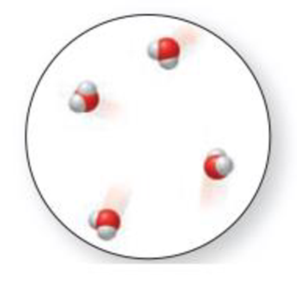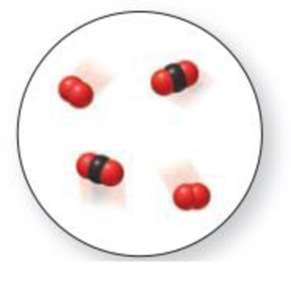
Principles of General, Organic, Biological Chemistry
2nd Edition
ISBN: 9780073511191
Author: Janice Gorzynski Smith Dr.
Publisher: McGraw-Hill Education
expand_more
expand_more
format_list_bulleted
Concept explainers
Textbook Question
Chapter 1.3, Problem 1.4P
Classify each example of molecular art as a pure substance or a mixture:


Expert Solution & Answer
Want to see the full answer?
Check out a sample textbook solution
Students have asked these similar questions
Using the following two half-reactions, determine the pH range in which $NO_2^-\ (aq)$ cannot be found as the predominant chemical species in water.* $NO_3^-(aq)+10H^+(aq)+8e^-\rightarrow NH_4^+(aq)+3H_2O(l),\ pE^{\circ}=14.88$* $NO_2^-(aq)+8H^+(aq)+6e^-\rightarrow NH_4^+(aq)+2H_2O(l),\ pE^{\circ}=15.08$
Indicate characteristics of oxodec acid.
What is the final product when hexanedioic acid reacts with 1º PCl5 and 2º NH3.
Chapter 1 Solutions
Principles of General, Organic, Biological Chemistry
Ch. 1.1 - Imagine that your job as a healthcare professional...Ch. 1.2 - Characterize each process as a physical change or...Ch. 1.2 - Does the molecular art represent a chemical change...Ch. 1.3 - Classify each example of molecular art as a pure...Ch. 1.3 - Prob. 1.5PCh. 1.3 - Classify each item as an element or a compound:...Ch. 1.4 - Prob. 1.7PCh. 1.4 - If a nanometer is one billionth of a meter (0.000...Ch. 1.4 - Prob. 1.9PCh. 1.4 - Prob. 1.10P
Ch. 1.5 - How many significant figures does each number...Ch. 1.5 - Indicate whether each zero in the following...Ch. 1.5 - Prob. 1.13PCh. 1.5 - Carry out each calculation and give the answer...Ch. 1.5 - Prob. 1.15PCh. 1.6 - Prob. 1.16PCh. 1.6 - Prob. 1.17PCh. 1.6 - Prob. 1.18PCh. 1.7 - Prob. 1.19PCh. 1.7 - Prob. 1.20PCh. 1.7 - Prob. 1.21PCh. 1.7 - Carry out each of the following conversions. a....Ch. 1.8 - Prob. 1.23PCh. 1.8 - A patient is prescribed 0.100 mg of a drug that is...Ch. 1.8 - Prob. 1.25PCh. 1.9 - Prob. 1.26PCh. 1.9 - Prob. 1.27PCh. 1.10 - How does the mass of liquid A in cylinder [1]...Ch. 1.10 - Prob. 1.29PCh. 1.10 - Prob. 1.30PCh. 1 - Classify each example of molecular art as a pure...Ch. 1 - (a) Which representation(s) in Problem 1.31...Ch. 1 - When a chunk of dry ice (solid carbon dioxide) is...Ch. 1 - The inexpensive preparation of nitrogen-containing...Ch. 1 - a. What is the temperature on the given Fahrenheit...Ch. 1 - (a) What is the length of the given crayon in...Ch. 1 - Prob. 1.37UKCCh. 1 - Prob. 1.38UKCCh. 1 - Prob. 1.39UKCCh. 1 - Red light has a wavelength of 683 nm. Convert this...Ch. 1 - Prob. 1.41UKCCh. 1 - Prob. 1.42UKCCh. 1 - Prob. 1.43UKCCh. 1 - Prob. 1.44UKCCh. 1 - Label each component in the molecular art as an...Ch. 1 - Label each component in the molecular art as an...Ch. 1 - Describe solids, liquids, and gases in terms of...Ch. 1 - Prob. 1.48APCh. 1 - Prob. 1.49APCh. 1 - Classify each process as a chemical or physical...Ch. 1 - Which quantity in each pair is larger? a. 5 mL or...Ch. 1 - Which quantity in each pair is larger? a. 10 km or...Ch. 1 - Label each quantity as an exact or inexact number....Ch. 1 - Rank the quantities in each group from smallest to...Ch. 1 - How many significant figures does each number...Ch. 1 - Prob. 1.56APCh. 1 - Round each number to three significant figures. a....Ch. 1 - Prob. 1.58APCh. 1 - Prob. 1.59APCh. 1 - Prob. 1.60APCh. 1 - Prob. 1.61APCh. 1 - Prob. 1.62APCh. 1 - Prob. 1.63APCh. 1 - Prob. 1.64APCh. 1 - Prob. 1.65APCh. 1 - Rank the numbers in each group from smallest to...Ch. 1 - Write the recommended daily intake of each...Ch. 1 - Prob. 1.68APCh. 1 - Prob. 1.69APCh. 1 - Carry out each of the following conversions. a. 25...Ch. 1 - Prob. 1.71APCh. 1 - Prob. 1.72APCh. 1 - Prob. 1.73APCh. 1 - Prob. 1.74APCh. 1 - Prob. 1.75APCh. 1 - Prob. 1.76APCh. 1 - Prob. 1.77APCh. 1 - Prob. 1.78APCh. 1 - Prob. 1.79APCh. 1 - Prob. 1.80APCh. 1 - Prob. 1.81APCh. 1 - Prob. 1.82APCh. 1 - Which is the upper layer when each of the...Ch. 1 - Prob. 1.84APCh. 1 - A lab test showed an individuals cholesterol level...Ch. 1 - Prob. 1.86APCh. 1 - Liposuction is a cosmetic procedure used to remove...Ch. 1 - Prob. 1.88APCh. 1 - Prob. 1.89APCh. 1 - Prob. 1.90APCh. 1 - Prob. 1.91APCh. 1 - Prob. 1.92APCh. 1 - Prob. 1.93CPCh. 1 - Prob. 1.94CPCh. 1 - Prob. 1.95CPCh. 1 - Prob. 1.96CPCh. 1 - A soccer player weighed 70.7 kg before a match,...Ch. 1 - Prob. 1.98CP
Knowledge Booster
Learn more about
Need a deep-dive on the concept behind this application? Look no further. Learn more about this topic, chemistry and related others by exploring similar questions and additional content below.Similar questions
- What is the final product when D-galactose reacts with hydroxylamine?arrow_forwardIndicate the formula of the product obtained by reacting methyl 5-chloro-5-oxopentanoate with 1 mole of 4-penten-1-ylmagnesium bromide.arrow_forwardIn the two chair conformations of glucose, the most stable is the one with all the OH groups in the equatorial position. Is this correct?arrow_forward
- please help me with my homeworkarrow_forwardhelparrow_forwardThe temperature on a sample of pure X held at 1.25 atm and -54. °C is increased until the sample boils. The temperature is then held constant and the pressure is decreased by 0.42 atm. On the phase diagram below draw a path that shows this set of changes. pressure (atm) 2 0 0 200 400 temperature (K) Xarrow_forward
- QUESTION: Answer Question 5: 'Calculating standard error of regression' STEP 1 by filling in all the empty green boxes *The values are all provided in the photo attached*arrow_forwardpressure (atm) 3 The pressure on a sample of pure X held at 47. °C and 0.88 atm is increased until the sample condenses. The pressure is then held constant and the temperature is decreased by 82. °C. On the phase diagram below draw a path that shows this set of changes. 0 0 200 temperature (K) 400 аarrow_forwarder your payment details | bar xb Home | bartleby x + aleksogi/x/isl.exe/1o u-lgNskr7j8P3jH-1Qs_pBanHhviTCeeBZbufuBYT0Hz7m7D3ZcW81NC1d8Kzb4srFik1OUFhKMUXzhGpw7k1 O States of Matter Sketching a described thermodynamic change on a phase diagram 0/5 The pressure on a sample of pure X held at 47. °C and 0.88 atm is increased until the sample condenses. The pressure is then held constant and the temperature is decreased by 82. °C. On the phase diagram below draw a path that shows this set of changes. pressure (atm) 1 3- 0- 0 200 Explanation Check temperature (K) 400 X Q Search L G 2025 McGraw Hill LLC. All Rights Reserved Terms of Use Privacy Cearrow_forward
arrow_back_ios
SEE MORE QUESTIONS
arrow_forward_ios
Recommended textbooks for you
- Chemistry: Matter and ChangeChemistryISBN:9780078746376Author:Dinah Zike, Laurel Dingrando, Nicholas Hainen, Cheryl WistromPublisher:Glencoe/McGraw-Hill School Pub Co

 Introductory Chemistry: A FoundationChemistryISBN:9781337399425Author:Steven S. Zumdahl, Donald J. DeCostePublisher:Cengage Learning
Introductory Chemistry: A FoundationChemistryISBN:9781337399425Author:Steven S. Zumdahl, Donald J. DeCostePublisher:Cengage Learning  World of Chemistry, 3rd editionChemistryISBN:9781133109655Author:Steven S. Zumdahl, Susan L. Zumdahl, Donald J. DeCostePublisher:Brooks / Cole / Cengage Learning
World of Chemistry, 3rd editionChemistryISBN:9781133109655Author:Steven S. Zumdahl, Susan L. Zumdahl, Donald J. DeCostePublisher:Brooks / Cole / Cengage Learning Chemistry for Today: General, Organic, and Bioche...ChemistryISBN:9781305960060Author:Spencer L. Seager, Michael R. Slabaugh, Maren S. HansenPublisher:Cengage Learning
Chemistry for Today: General, Organic, and Bioche...ChemistryISBN:9781305960060Author:Spencer L. Seager, Michael R. Slabaugh, Maren S. HansenPublisher:Cengage Learning

Chemistry: Matter and Change
Chemistry
ISBN:9780078746376
Author:Dinah Zike, Laurel Dingrando, Nicholas Hainen, Cheryl Wistrom
Publisher:Glencoe/McGraw-Hill School Pub Co


Introductory Chemistry: A Foundation
Chemistry
ISBN:9781337399425
Author:Steven S. Zumdahl, Donald J. DeCoste
Publisher:Cengage Learning

World of Chemistry, 3rd edition
Chemistry
ISBN:9781133109655
Author:Steven S. Zumdahl, Susan L. Zumdahl, Donald J. DeCoste
Publisher:Brooks / Cole / Cengage Learning


Chemistry for Today: General, Organic, and Bioche...
Chemistry
ISBN:9781305960060
Author:Spencer L. Seager, Michael R. Slabaugh, Maren S. Hansen
Publisher:Cengage Learning
Types of Matter: Elements, Compounds and Mixtures; Author: Professor Dave Explains;https://www.youtube.com/watch?v=dggHWvFJ8Xs;License: Standard YouTube License, CC-BY